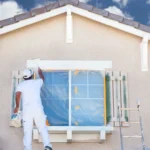Choosing the right exterior paint color can make or break your home’s curb appeal. It’s not just about picking a shade you like—it’s about finding a color that works with your home’s architecture, the surrounding environment, neighborhood trends, and your long-term maintenance goals.
Understand Your Home’s Architectural Style
Different architectural styles tend to look best with certain color palettes. Here’s a quick reference:
| Architectural Style | Recommended Color Palette |
|---|---|
| Colonial | Whites, creams, dark blues, and grays |
| Victorian | Bold, multi-color schemes, rich tones |
| Mediterranean | Warm earth tones, terracotta, ochre, olive |
| Ranch or Mid-century | Neutral tones, earthy hues, mid-century pastels |
| Modern or Contemporary | Stark contrasts, monochrome schemes |
Before making a decision, research your home’s design roots. Matching your paint to the architecture maintains historical integrity and visual harmony.
Factor in the Roof and Fixed Features
Your roof, pathways, brickwork, and any other elements that won’t be painted need to be considered. If you have a red or orange tile roof, for example, a cooler color like blue or green might clash. Instead, choose complementary tones that blend well.
Consider the Surroundings
Take cues from the environment around your home. If you live in a wooded area, earthy tones like browns, greens, and taupes can blend beautifully. In urban settings, neutral and bold colors often stand out well. Coastal homes often look great in whites, light blues, and sandy tones.
Think Long-Term Maintenance

Darker colors tend to fade faster in direct sunlight. Lighter colors may show less dirt but more mildew in humid areas. Consider how much upkeep you’re willing to handle. High-quality, fade-resistant paint can mitigate some of these issues.
Use the 60-30-10 Rule
This interior design rule applies to exteriors as well:
- 60% of the home should be the main color
- 30% should be a secondary color (like trim or shutters)
- 10% should be an accent color (like the front door)
Test Before You Commit
Paint looks different in sunlight, shade, and at different times of the day. Always test a few sample colors on different areas of your home before deciding.
Neighborhood Harmony and HOA Rules
While you want your home to reflect your personality, it should also complement nearby homes. Some neighborhoods or HOAs have strict guidelines. Always check local rules before buying paint.
Trending Yet Timeless Colors
While trends can inspire, timeless colors ensure longevity.
Current Popular Exterior Colors:
| Color Name | Description | Works Best With |
|---|---|---|
| Greige | Gray-beige hybrid | Modern, transitional homes |
| Navy Blue | Deep, bold blue | White or light-colored trims |
| Sage Green | Muted green with gray undertones | Wood and stone accents |
| Charcoal Gray | Dark, sophisticated gray | Modern homes, bright trims |
| Creamy White | Soft, warm white | All architectural styles |
Eco-Friendly Paint Options
Low-VOC and no-VOC paints are better for the environment and your health. Brands like Benjamin Moore’s Natura and Sherwin-Williams’ Harmony offer sustainable options.
Hire a Color Consultant

If you’re feeling overwhelmed, a professional color consultant can help narrow down your options. Some paint companies even offer this service for free or at a low cost with a purchase.
Use Online Visualizers
Most major paint brands offer free online tools that let you upload a photo of your home and try different colors virtually. This can be a game changer for visualizing the final result.
ALSO READ: How to Write Compelling Blog Posts That Keep Readers Coming Back?
Conclusion
Choosing the right exterior paint color is both an art and a science. By considering your home’s architecture, surroundings, fixed features, and personal taste—and by testing your options and keeping an eye on maintenance—you can select a color that enhances your home’s beauty and value for years to come. Take your time, explore your options, and remember: the right color is out there.






